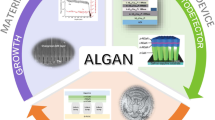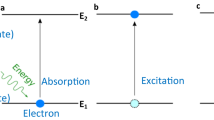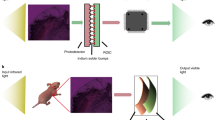Abstract
Many researchers have been trying to produce highly efficient solid-state devices with longer operating lives for the far-ultraviolet wavelength region as an alternative to conventional far-ultraviolet lamps. However, owing to the low efficiency of far-ultraviolet operation, research continues into the development of far-ultraviolet devices with sufficiently high performance1,2. Here, the potential of hexagonal boron nitride as a far-ultraviolet fluorescent material is studied. Specifically, taking advantage of the highly luminous properties of hexagonal boron nitride3, a far-ultraviolet plane-emission compact device equipped with a field-emission array4 as an excitation source is fabricated, and its stable operation with an output power of 0.2 mW at 225 nm demonstrated. Because of its low current consumption in operation, the device can be driven by dry batteries. This convenient far-ultraviolet device is likely to prove extremely useful in photochemical and biotechnological applications such as photocatalysis, sterilization and modification of chemical substances.
This is a preview of subscription content, access via your institution
Access options
Subscribe to this journal
Receive 12 print issues and online access
$209.00 per year
only $17.42 per issue
Buy this article
- Purchase on Springer Link
- Instant access to full article PDF
Prices may be subject to local taxes which are calculated during checkout





Similar content being viewed by others
References
Hecht, J. Materials are a tough challenge for ultraviolet diode lasers. Laser Focus World 44, 67–71 (2008).
Khan, A., Balakrishnan, K. & Katona, T. Ultraviolet light-emitting diodes based on group three nitrides. Nature Photon. 2, 77–84 (2008).
Watanabe, K., Taniguchi, T. & Kanda, H. Direct-bandgap properties and evidence for ultraviolet lasing of hexagonal boron nitride single crystal. Nature Mater. 3, 404–409 (2004).
Spindt, C. A., Brodie, I., Humphrey, L. & Westerberg, E. R. Physical properties of thin-film field-emission cathodes with molybdenum cones. J. Appl. Phys. 47, 5248–5263 (1976).
Nakamura, S. et al. InGaN-based multi-quantum-well-structure laser diodes. Jpn J. Appl. Phys. 35, L74–L76 (1996).
Nakamura, S. et al. InGaN/GaN/AlGaN-based laser diodes with modulation-doped strained-layer superlattices grown on an epitaxially laterally overgrown GaN substrate. Appl. Phys. Lett. 72, 211–213 (1998).
Itoh, S. et al. Development of field-emission displays. J. Soc. Inf. Display 15, 1057–1064 (2007).
Watanabe, K., Taniguchi, T., Kuroda, T. & Kanda, H. Effects of deformation on band-edge luminescence of hexagonal boron nitride single crystals. Appl. Phys. Lett. 89, 141902 (2006).
Watanabe, K., Taniguchi, T., Kuroda, T. & Kanda, H. Band-edge luminescence of deformed hexagonal boron nitride single crystals. Diam. Relat. Mater. 15, 1891–1893 (2006).
Watanabe, K., Taniguchi, T. & Kanda, H. Ultraviolet luminescence spectra of boron nitride single crystals grown under high pressure and high temperature. Phys. Status Solidi A 201, 2561–2565 (2004).
Jaffrennou, P. et al. Origin of the excitonic recombinations in hexagonal boron nitride by spatially resolved cathodoluminescence spectroscopy. J. Appl. Phys. 102, 116102 (2007).
Museur, L. & Kanaev, A. Near band-gap photoluminescence properties of hexagonal boron nitride. J. Appl. Phys. 103, 103520 (2008).
Museur, L., Feldbach, E. & Kanaev, A. Defect-related photoluminescence of hexagonal boron nitride. Phys. Rev. B 78, 155204 (2008).
Watanabe, K. & Taniguchi, T. Jahn–Teller effect on exciton states in hexagonal boron nitride single crystal. Phys. Rev. B 79, 193104 (2009).
Taniguchi, T. & Watanabe, K. Synthesis of high-purity boron nitride single cyrstals under high pressure by using Ba-BN solvent. J. Crys. Growth 303, 525–529 (2007).
Acknowledgements
This research was partially supported by Grants-in-Aid for Scientific Research (A), 19205026, 2007, Priority Areas ‘Nano Materials Science for Atomic Scale Modification 474’ and the Grant-in-Aid for World Premiere Research Institute (WPI) Initiative (MANA@NIMS). All grants were promoted by the Ministry of Education, Culture, Sports, Science and Technology (MEXT), Japan.
Author information
Authors and Affiliations
Contributions
K.W. and T.T. prepared the highly luminous hBN powders, and T.N., K.M. and M.T. fabricated the FED structured devices. All tests on device performance were carried out by the authors.
Corresponding author
Rights and permissions
About this article
Cite this article
Watanabe, K., Taniguchi, T., Niiyama, T. et al. Far-ultraviolet plane-emission handheld device based on hexagonal boron nitride. Nature Photon 3, 591–594 (2009). https://doi.org/10.1038/nphoton.2009.167
Received:
Accepted:
Published:
Issue Date:
DOI: https://doi.org/10.1038/nphoton.2009.167
This article is cited by
-
Cathodoluminescence spectroscopy of monolayer hexagonal boron nitride
Scientific Reports (2024)
-
Porous heterostructure of h-BN/carbon as an efficient electrocatalyst for hydrogen peroxide generation
Carbon Letters (2024)
-
Interfacial interaction and intense interfacial ultraviolet light emission at an incoherent interface
Nature Communications (2023)
-
Towards n-type conductivity in hexagonal boron nitride
Nature Communications (2022)
-
Deep-ultraviolet electroluminescence and photocurrent generation in graphene/hBN/graphene heterostructures
Nature Communications (2021)



